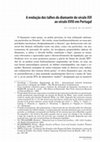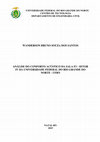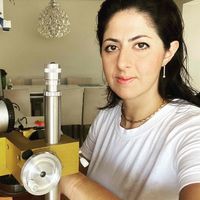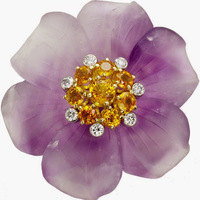Videos by Rui Galopim de Carvalho
In our 8th Home Gemmology webinar, held on April 14, 2020, with the support of CIBJO - The World ... more In our 8th Home Gemmology webinar, held on April 14, 2020, with the support of CIBJO - The World Jewellery Confederation, we’ll discuss the most famous red gemstone, ruby, in a historical perspective and with a special focus on Mogok in Myanmar, former Burma, as an historical source for fine quality rubies including the 196.1 carat Hixon ruby, currently at the Natural History Museum of Los Angeles. Lavish jewellery, like the Patiala ruby choker by Cartier have been made using this rare gem. A brief walk through ruby nomenclature and along other historical and modern sources of ruby will be made in his talk in simple language for all to understand. 94 views
The 5th Home Gemmology webinar held on April 5 2020 during the covid-19 lockdown period, is on a ... more The 5th Home Gemmology webinar held on April 5 2020 during the covid-19 lockdown period, is on a gemmologist's perspective of René Lalique jewellery. The discussion will be essentially around the gem materials used by famed French Art Nouveau artist, illustrated mostly with the vast collection housed at the Calouste Gulbenkian Museum in Lisbon, Portugal. His choices from coloured gemstones to biogenic gem materials, diamonds and glass, are related to the available sources at the period when he created his masterpieces in the late 1800s to the early 1900s. 67 views
In the 16th edition of the Home Gemmology webinar held on May 19, 2020, with the support of CIBJO... more In the 16th edition of the Home Gemmology webinar held on May 19, 2020, with the support of CIBJO - the World Jewellery Confederation, I'll be telling stories about some of the most remarkable pearls in history, from notable archaeological finds to the famous Cleopatra's pear-shaped pearl tale, to unusually large pearls and natural blisters, as well as fascinating stories of pearls that belonged to royalty, some fetching record-breaking numbers at auction in the last few years.
Clarification on proper pearl nomenclature will be also covered in line with CIBJO pearl standards in the CIBJO Blue Books. 76 views
The 17th Home Gemmology webinar held in May 26, 2020, with the support of CIBJO and co-hosted by ... more The 17th Home Gemmology webinar held in May 26, 2020, with the support of CIBJO and co-hosted by Edward Johnson, covers Brazilian diamonds and their impact in jewellery, especially in the 1700s, with examples from Portuguese Crown Jewels. Some notable diamonds will illustrate the talk, including very rare Fancy reds, large famous local finds and stones from the new Braúna kimberlite pipe in Bahia, the first diamantiferous kimberlite in full production in the country.
This topic is a re-make of the 3rd Home Gemmology webinar that took place in late March and was offered after repeated calls to do it again. 86 views
The 21st Home Gemmology webinar held on June 23, 2020, on biogenic gem materials (or should we st... more The 21st Home Gemmology webinar held on June 23, 2020, on biogenic gem materials (or should we still say organics?), is finally on YouTube! Here we discuss their varieties and terminology, with examples mostly from artefacts of Portuguese cultural heritage of the 16th and 17th centuries. And because today, there is an awareness of conservation and sustainability issues, we also talk about the trade of some of those gem materials that is regulated by CITES, the Convention on International Trade of Endangered Species of Flora and Fauna as a clarification is needed to understand exactly what does it mean to be listed in one of the three CITES Appendices. 22 views
In our 7th Home Gemmology webinar, held April 10, 2020, with the support of CIBJO - The World Jew... more In our 7th Home Gemmology webinar, held April 10, 2020, with the support of CIBJO - The World Jewellery Confederation, during this long lockdown we have a special guest: Dr Eloïse Gaillou, a renown scientist specialised in opals and diamonds, currently curator of the historic Musée de Minéralogie MINES ParisTech in Paris, that will give a talk on how mineralogically and crystallographically perfect, or not, are the highly desirable fancy-coloured diamonds. Understanding the science behind them is critical to determine the authenticity of the colours that is indeed relevant to the trade and laboratory reports. We will have the privilege of having Eloïse walking us though that science in simple words. 141 views
In our 10th Home Gemmology webinar, held on April 10, 2020,, I've decided to repeat one topic now... more In our 10th Home Gemmology webinar, held on April 10, 2020,, I've decided to repeat one topic now that CIBJO, the World Jewellery Confederation is supporting it. After surveying opinions on social media, emerald, the gemstone covered in the 1st Home Gemmology webinar on March 18th 2020, got the highest voting score!
The presentation covers the definition of an emerald, nomenclature standards, erroneous trade names, the history of the early sources and the challenges in geographic origin origin determination wneh compared with geological origin determination on a laboratory. This talk was first presented at the GemTalks organized by IGI - Istituto Gemmologico Italiano at Vicenzaoro and also offered at the Gem Tips at AIGS Thaliand. 52 views
Diamonds are the featured gemstone in the 11th Home Gemmology webinar held on April 24, 2020, wit... more Diamonds are the featured gemstone in the 11th Home Gemmology webinar held on April 24, 2020, with the support of CIBJO - The World Jewellery Confederation. Their history illustrated with some famous diamonds, the history if the imitations and synthetics, and a brief insight into how they have been valued are the main topics of the session. Relevant trade names like Golconda and Cape will be discussed. 91 views
Papers by Rui Galopim de Carvalho

R u i G a l o p i m d e C a r v a l h o * O diamante como gema, ou pedra preciosa, já tem utiliza... more R u i G a l o p i m d e C a r v a l h o * O diamante como gema, ou pedra preciosa, já tem utilização milenar, em particular no Oriente 1. Até então, eram fundamentalmente as suas propriedades mecânicas, designadamente a dureza 2 , que destacavam este mineral dos demais utilizados tanto em jóias, como, em particular, em instrumentos de gravação de pedra. As invulgares propriedades ópticas do diamante, a saber, o elevado brilho, cintilação e fogo 3 , apenas se tornaram relevantes e apreciadas após o desenvolvimento da lapidação, que no Ocidente teve os seus primeiros passos a partir de fi nais do século XIV 4. Até lá, as pedras eram habitualmente engastadas em bruto, ou seja, na sua forma mineralógica natural, ou hábito cristalográfi co, em regra o octaedro. Existem exemplos de anéis romanos onde se observa esta utilização rudimentar dos cristais desta gema 5. A estes diamantes que, em jóia, se assemelhavam a uma pirâmide quadrangular dava-se o nome de "ponta" e, já no século XVI, de diamantes "naifes" 6 , designação que se manteve * Gemólogo e Consultor. Embaixador da ICA-International Colored Gemstone Association e delegado da CIBJO-The World Jewellery Confederation. 1 Uma excelente referência para a história da utilização do diamante encontra-se em HARLOW, George E., coord.-The Nature of Diamonds. New York: American Museum of Natural History, 1998. 2 Propriedade física que representa a resistência dos materiais à abrasão ou à penetração, sendo geralmente apresentada em função da Escala de Mohs, uma escala numérica relativa criada pelo alemão Frederick Mohs, em 1822, dispondo dez minerais comuns numa sequência de 1 a 10, dos menos aos mais duros, sendo que os de número superior riscam os de menor número, nunca sendo riscados por estes: 1-Talco,

The Journal of Gemmology, 2020
No presente trabalho foi estudado o conforto acústico do ambiente acadêmico da Universidade Feder... more No presente trabalho foi estudado o conforto acústico do ambiente acadêmico da Universidade Federal do Rio Grande do Norte, visando conformidade com as normas: NBR 10151, NBR 10152 e NBR 12179. Inicialmente, consta uma breve fundamentação teórica de conceitos necessários para compreensão dos ensaios e resultados. Em seguida foram realizados ensaios in loco e métodos conceituais empíricos. As análises foram referentes a: 1) Níveis de ruído interno; 2) Tempo de reverberação; 3) Espectro de frequências sonoras propagadas dentro dos ambientes em questão. Sendo o primeiro item diretamente ligado à saúde e conforto, enquanto os demais estão relacionados às questões de inteligibilidade. Os resultados obtidos foram discutidos, analisados e comparados entre si e com os critérios normativos. Os resultados não estiveram dentro do esperado. Por isso, conclui-se que para o devido atendimento das recomendações normativas, esse artigo serve como base de pesquisa para soluções de isolamento e tratamento acústico para os problemas diagnosticados.
The Journal of Gemmology, 2014
This review of the evolution of diamond cuts during the 16th to 18th centuries is illustrated wit... more This review of the evolution of diamond cuts during the 16th to 18th centuries is illustrated with Portuguese jewellery and sacred objects from this period. We follow the evolution from point cuts already in existence prior to Portuguese navigational discoveries in the late 15th century, to table and rose cuts that co-existed for most of the 16th and 17th centuries, to the now-called old brilliant (or old mine) cut, which became popular a few decades after the discovery of the Brazilian diamond fields in the 1720s. The use of each cut and shifts in their popularity are discussed. These observations of diamond cuts in Portuguese jewellery and devotional objects may also be applicable to trends within wider European manufacture.
InColor, 2010
Brazil is today one of the world’s major gem producers, although it was only in the last quarter ... more Brazil is today one of the world’s major gem producers, although it was only in the last quarter of the 20th century that its position was recognized internationally. Yet, as far back as the 18th century, while still a Portuguese territory, Brazil took its first steps towards its present day status in the gemological world.
Rui Galopim de Carvalho Blog, Feb 1, 2021
Jules Roger Sauer, founder of the iconic 75 year old Amsterdam Sauer gem and jewellery chain in B... more Jules Roger Sauer, founder of the iconic 75 year old Amsterdam Sauer gem and jewellery chain in Brazil, was a gem passionate, visionary and adventurer that contributed decisively to the early development of the modern gem and jewellery industries in Brazil.
Rui Galopim de Carvalgo Blog, Jun 12, 2020
Apart from painting, jewellery is not that much represented in the other arts. In music, for exam... more Apart from painting, jewellery is not that much represented in the other arts. In music, for example, there are clear mentions to gems and jewels on many lyrics but it is a performing dance piece that features jewellery as the key element of an artistic piece: "Jewels”, a ballet by George Balanchine. A 21th century reinterpretation of this piece brings together names like Van Cleef & Arpels, Benjamin Millepied and the famous composer Phillip Glass, all for the sake of gems.
Rui Galopim de Carvalho Blog, Jul 11, 2020
Only on rare occasions do we see lavish jewellery at the centre of a motion picture’s plot. Ocean... more Only on rare occasions do we see lavish jewellery at the centre of a motion picture’s plot. Ocean’s 8, directed by Garry Ross, released in 2018, is a remarkable recent example. Cartier joined Warner Brothers in the meticulous manufacture of a recreation of a long lost famous diamond necklace that belonged to Maharajah Nawangar: a $150 million dollar jewel that is the target of a all-female crew, leaded by Debbie Ocean (Sandra Bullock) at a famed yearly event in New York city’s Metropolitan Museum of Art.
Rui Galopim de Carvalho Blog, Sep 28, 2020
There are a few trade names and expressions that are not exactly accurate if we look at them in a... more There are a few trade names and expressions that are not exactly accurate if we look at them in a very strict way. However, written or verbal tradition have given them a wide visibility and usage among both professionals and the general public, and many have became part of the trade’s vernacular and nomenclature. Here are a few examples.
Rui Galopim de Carvalho Blog, Sep 7, 2020
Along with other biogenic substances, precious corals are among the oldest gem materials used by ... more Along with other biogenic substances, precious corals are among the oldest gem materials used by humankind since the Iron Age. The material corresponds to the bio-mineralized exoskeleton of limited numbers of marine species of the phylum Cnidaria that thrive in various parts of the world.
Rui Galopim de Carvalho Blog, Aug 8, 2020
The gemmological content of this devotional implement from the early 1800’s is very interesting i... more The gemmological content of this devotional implement from the early 1800’s is very interesting in various aspects. From its gem materials to their fashioning and settings, the monstrance also shows evidences of the use of profane jewellery adapted to this religious context and it is a good example of the use of gem materials in the period. The article also shows how does a gemmological approach may be made in such historical artefacts using simple gem testing techniques and its content discussed in light of the coloured gemstone production at the time of manufacture in Portugal.
Rui Galopim de Carvalho BLog, Jul 27, 2020
This is the fantastic story of a millionaire exchange of a New York City lavish mansion for a Car... more This is the fantastic story of a millionaire exchange of a New York City lavish mansion for a Cartier two strand necklace of high-quality natural pearls. That is how much pearls were worth in the early 20th century.










Uploads
Videos by Rui Galopim de Carvalho
Clarification on proper pearl nomenclature will be also covered in line with CIBJO pearl standards in the CIBJO Blue Books.
This topic is a re-make of the 3rd Home Gemmology webinar that took place in late March and was offered after repeated calls to do it again.
The presentation covers the definition of an emerald, nomenclature standards, erroneous trade names, the history of the early sources and the challenges in geographic origin origin determination wneh compared with geological origin determination on a laboratory. This talk was first presented at the GemTalks organized by IGI - Istituto Gemmologico Italiano at Vicenzaoro and also offered at the Gem Tips at AIGS Thaliand.
Papers by Rui Galopim de Carvalho
Clarification on proper pearl nomenclature will be also covered in line with CIBJO pearl standards in the CIBJO Blue Books.
This topic is a re-make of the 3rd Home Gemmology webinar that took place in late March and was offered after repeated calls to do it again.
The presentation covers the definition of an emerald, nomenclature standards, erroneous trade names, the history of the early sources and the challenges in geographic origin origin determination wneh compared with geological origin determination on a laboratory. This talk was first presented at the GemTalks organized by IGI - Istituto Gemmologico Italiano at Vicenzaoro and also offered at the Gem Tips at AIGS Thaliand.
Estes estudos têm, assim, permitido trazer uma inédita quantidade de informações, o que veio a acrescentar de forma significativa o universo de conhecimento acerca das alfaias de culto em prata com pedrarias que, durante a segunda metade de setecentos e o início de oitocentos, foram sendo produzidas em Portugal. Verifica-se, assim, uma relativa correspondência entre as pedrarias usadas nas alfaias do culto e as que eram comuns na joalharia do quotidiano desse período. Convém relembrar que a joalharia portuguesa do séc. XVIII foi agraciada pela descoberta de inúmeras pedrarias no Brasil, designadamente o diamante na década de 1720, e, mais tarde, de topázios amarelos e imperiais, topázios incolores, cristal-de-rocha, ametista, crisoberilos, águas-marinhas, goshenites e granadas. Os vidros incolores, coloridos e dobletes foram, neste contexto, também amplamente utilizados. Acrescenta-se, ainda, o uso de folhetas reflectoras incolores e de cor que eram habitualmente colocadas sob as pedras nas cravações fechadas típicas da altura.
Como não será de estranhar, vê-se uma maior riqueza gemológica nas alfaias provenientes de templos de frequência real ou cortesã, contrastando com a maior modéstia dos que apoiam o culto nas zonas mais rurais e populares. Certo é que, na sua justa medida, as pedrarias que aí se encontram espelham a devoção dos fiéis, devendo ser entendidos mais como símbolos de fé do que como meros materiais preciosos de maior ou menos valor patrimonial.